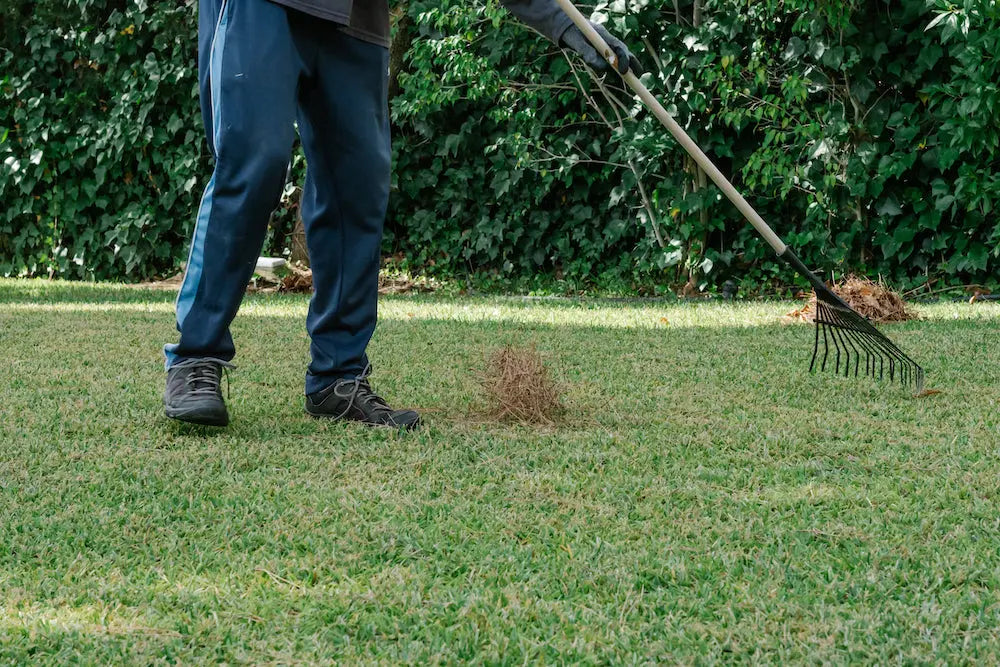Lawn thatch, the layer of organic material that forms between the soil and the green vegetation in your lawn, can be a hidden culprit behind many lawn care issues. While a thin layer of thatch is beneficial, excessive thatch can cause a range of problems, from poor water infiltration to increased susceptibility to pests and diseases. Identifying and treating thatch build-up is crucial for maintaining a healthy lawn. This article will guide you through the steps to identify and effectively treat thatch build-up.
What is Lawn Thatch?
Lawn thatch is composed of dead and living organic matter, including roots, stems, and shoots, that accumulates between the soil surface and the green vegetation. It is not the same as grass clippings, which decompose quickly. Thatch forms from parts of the grass that are more resistant to decomposition.
Identifying Thatch Build-Up
Identifying thatch build-up in your lawn involves a few simple steps:
-
Visual Inspection: Examine your lawn closely. If you notice that the grass feels spongy or bouncy when you walk on it, this may be an indication of excessive thatch.
-
Physical Check: Use a garden trowel or a shovel to remove a small section of turf, about 2-3 inches deep. Look at the cross-section of the turf. Thatch appears as a dense, spongy layer between the soil and the green grass blades. Measure the thickness of the thatch layer. A thatch layer thicker than 1/2 inch indicates a build-up that needs attention.
-
Probing: Insert a screwdriver or a soil probe into the lawn. If it is difficult to penetrate the soil, this may be due to a thick thatch layer.
Causes of Thatch Build-Up
Several factors contribute to thatch build-up, including:
-
Grass Species: Certain grass types, such as Kentucky bluegrass, Bermuda grass, and creeping red fescue, are more prone to thatch build-up due to their aggressive growth patterns and the production of excess root and stem material.
-
Soil Conditions: Poor soil aeration and compaction can slow down the decomposition of organic material, leading to thatch build-up. Soils with low microbial activity, often due to overuse of pesticides or poor soil health, are less effective at breaking down thatch.
-
Mowing Practices: Mowing too short or too infrequently can contribute to thatch accumulation. Cutting grass too short stresses the plants, leading to increased production of roots and stems, while infrequent mowing results in larger clippings that take longer to decompose.
-
Fertilization: Over-fertilizing, especially with high-nitrogen fertilizers, can promote excessive growth of grass roots and stems, leading to thatch build-up. Balanced fertilization is essential to avoid this issue.
-
Watering Practices: Overwatering or frequent shallow watering can lead to shallow root systems, which can contribute to thatch accumulation. Lawns with shallow roots are less efficient at taking up nutrients and more prone to thatch problems.
Treating Thatch Build-Up
Once you have identified thatch build-up, it’s time to take steps to treat it:
-
Mowing Practices: Maintain a consistent mowing schedule, keeping the grass at the recommended height for your specific grass type. Avoid cutting more than one-third of the grass blade at a time to reduce stress on the plants. Regular mowing helps to prevent thatch build-up.
-
Proper Fertilization: Use a balanced fertilization program based on soil test results. Avoid over-fertilizing with high-nitrogen fertilizers, which can promote excessive growth and thatch build-up.
-
Adequate Watering: Water your lawn deeply and infrequently to encourage deep root growth. This helps prevent shallow root systems that can contribute to thatch.
-
Soil Aeration: Aerate your lawn regularly to improve soil aeration and reduce compaction. Aeration helps promote microbial activity in the soil, aiding in the decomposition of thatch. Aerating in the spring or fall, when grass is actively growing, is most effective.
-
Topdressing: Apply a thin layer of compost or soil over the lawn to help break down thatch. Topdressing introduces beneficial microorganisms that aid in decomposition and improve soil structure.
-
Mechanical Removal: If thatch accumulation becomes excessive (greater than 1/2 inch), mechanical removal may be necessary. Dethatching machines, also known as power rakes, can be used to remove the thick layer of thatch. This process should be done in the spring or early fall when the grass is actively growing and can recover quickly.
-
Using Biological Agents: Certain biological products, such as those containing beneficial fungi and bacteria, can be applied to the lawn to help break down thatch naturally. These products work by enhancing the microbial activity in the soil, promoting the decomposition of organic matter.
Preventing Future Thatch Build-Up
Preventing future thatch build-up involves maintaining good lawn care practices:
-
Regular Monitoring: Keep an eye on the thatch layer by performing regular visual and physical inspections. Early detection can prevent excessive build-up.
-
Balanced Lawn Care: Follow a balanced lawn care regimen that includes proper mowing, fertilization, watering, and aeration.
-
Soil Health: Promote soil health by reducing the use of pesticides and herbicides that can harm beneficial microorganisms. Consider using organic lawn care products.
-
Appropriate Grass Species: Choose grass species that are less prone to thatch build-up if you are establishing a new lawn or overseeding an existing one.
Conclusion
Lawn thatch can be both a beneficial and problematic component of your lawn ecosystem. By identifying and treating thatch build-up, you can maintain a healthy lawn. Regular monitoring, proper mowing, balanced fertilization, adequate watering, soil aeration, and, if necessary, mechanical removal or biological treatments can help you manage thatch effectively. With these practices, you can enjoy a lush, healthy lawn free of excessive thatch.








Reader Interactions